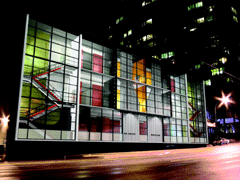
The garbage is getting picked up again, but behind the dumpster at city hall, plenty of heritage architecture has been left to rot.
In late July, just weeks into the strike, the city quietly put a moratorium on its robust heritage restoration program. That program was a win-win policy where the city would hand over "density units" to developers -- the right to build more square footage in a given area -- and the developers in turn agree to restore a significant heritage structure. By all accounts, it's been terrific: developers get to build more units or sell their rights to others; neighbourhoods get eco-density; vintage buildings get saved; and the public cash outlay is minimal. That's how Vancouver citizens got the Roundhouse Community Centre and the Stanley Theatre, to name just two big successes.
There are sidebar costs and complexities, for sure. But the basic premise of the moratorium suggests an economic tautology of Reagan-esque proportions: the heritage-rehab program is wildly successful, hence developers buy into it a lot, hence there's a big supply of density rights hanging in the air, hence the price might go down, hence the density rights might not be as attractive to the developers in the future. City hall insiders are calling the moratorium a "breather" -- but in the meantime, it's asphyxiating a slew of worthy projects.
Dal Grauer Substation: Modernist jewel
Of these, the Dal Grauer Substation is the most significant, I'd say, because of what it once achieved both symbolically and tangibly in fusing our civic culture. Showing the guts of the building and the infrastructure of electricity, the substation was public art in the truest, most inclusive sense. It marked the rare union of corporate and cultural Canada, when the head of B.C. Electric -- a legendary leader named Edward Albert "Dal" Grauer -- walked in tandem with the West Coast artistic community.
The substation was designed by architect Ned Pratt, a close friend of Grauer's, and incorporated a visible-from-the-street colour scheme by artist B.C. Binning. Using architecture as its medium, the substation conveyed the message that we -- the people and the utilities company -- were all on the same team. Or, at least, that we should be.
Since then, the colours have been painted over and the glass replaced with graying Plexiglas. Aside from being an eyesore, the architecture no longer invites the public to feel a part of it, just as in the popular mind Hydro has become the Other -- a faceless behemoth that issues those irritating monthly bills.
Now, Vancouver architect Peter Busby is poised to bring the Dal Grauer back to that privileged architectural representation. And how marvelously symbolic that Busby, renowned as the country's most "green" architect -- would restore the most culturally significant building of B.C. Hydro, which has been trying its damnedest in recent years to convince the public that it, too, cares deeply about the environment.
A different BC Hydro
But let's sort out the realpolitik: B.C. Hydro is a complexly structured leviathan. Some of its bureaucrats are said to be sensitive to potential public backlash on what they wrongly presume to be a "decorating" expense. (The restoration cost of $1.5 million would amount to perhaps 50 cents per Vancouver rate-payer and would barely register a hiccup on Hydro's mile-long balance sheet.) Insiders say that absent a density-transfer agreement from city hall, Hydro might play it politically safe and apply the barest minimum of no-frills upgrades to the building, and abandon -- perhaps forever -- the planned return to the 1950s ideal.
The restoration of the Dal Grauer is much more than decorating, though, and here's why: in the 1950s, when the substation and adjacent B.C. Electric head office (now the Electra condo tower) were built, industry and culture recognized and respected their mutual contribution to the community. Grauer enlisted his Pratt to rethink the company's plans for an opaque neo-classical building and instead create a building that the public would see as transparent and forward-looking. That was the image he wanted to project for B.C. Electric, and, with Binning's vervy colours, it worked.
'People were proud of it'
At that time, recalls former architecture professor Abraham Rogatnick, Vancouver had been a dreary pit-stop of a city. When the substation went up, it instantly charged up Burrard Street, making it a truly public space. "When we'd drive by, we'd slow down just to look at it," recalls Rogatnick. "When people saw all those wonderful B.C. Binning colours through the glass facade, it was exciting! It was one of the things to see in the city. People were proud of it."
Citizens from every social stratum took in the same vista: a showcase of art and technology whose message was that future-building was a group project. Is it still?
It's uncanny how buildings, like dogs, eventually come to resemble the personae of their owners. The current physical state of the Dal Grauer reflects a common perception -- fair or not -- of Hydro itself: opaque, dowdy, and disengaged from public life. Come to think of it, that pretty much applies to city hall as well. What a perfect civic gesture it would be to show us otherwise.
Related Tyee stories:
- The $18 Million Condo
Vancouver's new architectural paradigm: the insanely priced pied-á-terre. - Don't Forget the Country (text and gallery)
Michael Kluckner wants us to honour rural heritage buildings as well as urban ones. - How to Create Great Buildings (text and gallery)
Developers and governments must recognize that imagination isn't always expensive.















Tyee Commenting Guidelines
Comments that violate guidelines risk being deleted, and violations may result in a temporary or permanent user ban. Maintain the spirit of good conversation to stay in the discussion.
*Please note The Tyee is not a forum for spreading misinformation about COVID-19, denying its existence or minimizing its risk to public health.
Do:
Do not: